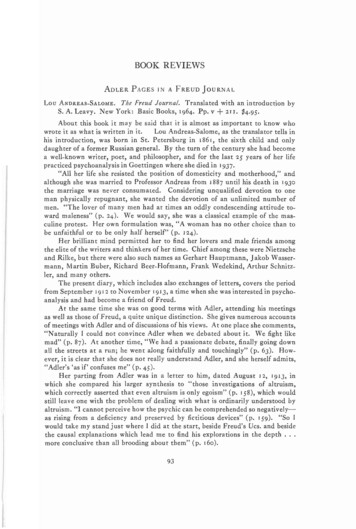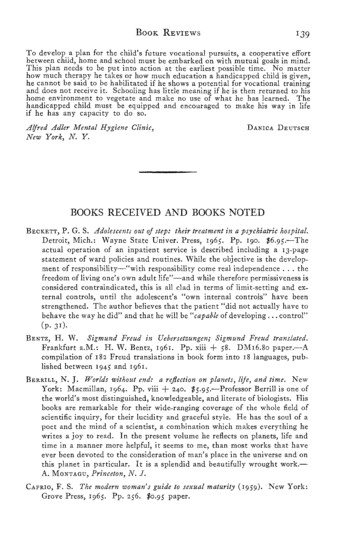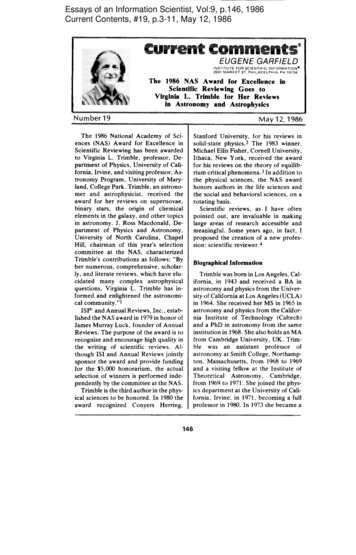
Transcription
BOOK REVIEWSADLER PAGES IN A FREUD JOURNALLou ANDREAS-SALOME. The Freud Journal. Translated with an introduction by2rr. 4.95.S. A. Leavy. New York: Basic Books, 1964. Pp. v About this book it may be said that it is almost as important to know whowrote it as what is written in it.Lou Andreas-Salome, as the translator tells inhis in troduction, was born in St. Petersburg in 186 I, the six th child and onlydaughter of a former Russian general. By the turn of the century she had becomea well-known writer, poet, and philosopher, and for the last 25 years of her lifepracticed psychoanalysis in Goettingen where she died in 1937."All her life she resisted the position of domesticity and motherhood," andalthough she was married to Professor Andreas from J887 until his death in 1930the marriage was never consumated. Considering unqualified devotion to oneman physically repugnant, she wanted the devotion of an unlimited number ofmen. "The lover of many men had at times an oddly condescending attitude toward maleness" (p. 24). We would say, she was a classical example of the masculine protest. Her own formulation was, "A woman has no other choice than tobe unfai thful or to be only half herself" (p. J 24).Her brilliant mind permitted her to find her lovers and male friends amongthe elite of the writers and thinkers of her time. Chief among these were Nietzscheand Rilke, but there were also such names as Gerhart Hauptmann, Jakob Wassermann, Martin Buber, Richard Beer-Hofmann, Frank Wedekind, Arthur Schnitzler, and many others.The present diary, which includes also exchanges of letters, covers the periodfrom September 1912 to November [9J 3, a time when she was interested in psychoanalysis and had become a friend of Freud.At the same time she was on good terms wi th Adler, attending his meetingsas well as those of Freud, a quite unique distinction. She gives numerous accountsof meetings wi th Adler and of discussions of his views. At one place she commen ts,"Naturally I could not convince Adler when we debated about it. We fight likemad" (p. 87). At another time, "We had a passionate debate, finally going downall the streets at a run; he went along faithfully and touchingly" (p. 63). However, it is clear that she does not really understand Adler, and she herself admits,"Adler's 'as if' confuses me" (p. 45).Her parting from Adler was in a letter to him, dated August J 2, 1913, inwhich she compared his larger synthesis to "those investigations of altruism,which correctly asserted that even altruism is only egoism" (p. 158), which wouldstill leave one with the problem of dealing with what is ordinarily understood byaltruism. "} cannot perceive how the psychic can be comprehended so negativeJyas rising from a deficiency and preserved by fictitious devices" (p. 159). "So Jwould take my stand just where I did at the start, beside Freud's Ucs. and besidethe causal explanations which lead me to find his explorations in the depth .more conclusive than all brooding about them" (p. 160).93
94BOOK REVIEWSTo this Adler replied on August J 6: "J would reproach you above all for beingso unwary." Then he went on: "There is a hitch in your analogy regarding altruism and egoism. J have maintained plainly enough that the nervous person hasjust that kind of sexuality and that degree of libido needed to rescue his feeling ofindividuality Iself-esteem]. And the same holds for his verbal modes of expression . . . They are . but constructs which the body creates as it presses to expand.That is how I can account for the libidinal transformations and even the teleological significance of the libido itself. But the expansive tendency can be accounted for on the basis of the libido only if the libido itself is assumed to have ayen for expansion" (pp. 160-161).This is followed by a formulation which summarizes rather well Adler's position as of this period. "Psyche is a name for the life-poten tiali ty of an inferiorcreature. And it comprises the aggressive instinct, the tendency toward expansion,and a reaching out for that which is more highly valued culturally-the male"(p. 161).With regard to Freud's "causal explanations" which Lou Andreas-Salomeaccepted as facts he had discovered, Adler commented: "Every single patient ofmine makes discoveries of that sort" (p. 161), meaning he "discovers" "objective"causes in the past to explain his difficulties, thus escaping responsibility for hisactions and preserving a clean conscience. But such explanations are fictions ordevices, and "Freud has taken his device for a reality. . . . And now perforce heinvents more fictions to cover up his deficiencies" (p. 161).With all that went a certain tone of bitterness in Adler. "Why is it that thatschool [Freud's] attempts to treat our views as common property, whereas we havealways insisted on the errors of their opinions? . To me this is all proof thatFreud's school does not believe in its own doctrines and really only wants to safeguard its investment" (p. 160). "My opinions might be wrong! But is that a goodenough reason to steal them too?" (p. 161).The author's discussion with Adler regarding his interest in Marx is also worthmentioning, because our knowledge of this topic is still sketchy and the accountfound here appears to be valid, in the light of other information we have. Thuswe find: "Conversing with Adler I was much enlightened by the history of hisdevelopment as a student of Marx, primarily interested in economics and philosophic speculation. Just as with the proletariat, social utopianism is supportedon the basis of envy and hate, so, in Adler's view of the child, the exalted utopianideal of personality arises on the basis of social comparison. Hence his rationalistic milieu therapy-and between it and the doctrine of organ inferiority ., theFreudian Dcs. falls to the ground-as it were between bodily defects and theformation of ideals" (p. 42).In view of her personality, it is not surprising that Lou Andreas-Salomefavored Freud. Even from her first meeting with Adler she went away with thenotation, "To me every neurosis appears to be mutual conflict between ego andsexuality" (pp. 34-35). Accordingly she arrived at the final conclusion, "Freudis right" (p. 132). But the translator raises the question "whether she has anything to offer the student of psychoanalysis-anything beyond the history of anexceptional personality . or is she to be thought of only as one of our hypotheticalpatients?" (p. 25).University oj VermontHEINZL.ANSBACHER
BOOK REVIEWS95REPRESSJON: OBSERVAT10N OR INFERENCE?Freud's Concept oj Repression and Defense: Its Theoretical andObservational Language.Minneapolis, Minn.:University of MinnesotaPress, 196 l. Pp. 205. 4.75.PETER MADISON.This book was stimulated by an academic psychologist's keen puzzlementabout the gap between the experimental laboratory and the clinic, focussedaround the key concept of repression. While the contems of the book itself wouldmake excellent reading requirement for all graduate students in psychology, theunusual effort of the author to straddle the worlds of controlled research andviable practice is even more admirable.The author's first step was to seek the thread of implication and consistencyin Freud's writings, Freud's vacillations between usage of repression in a specificand a generic sense are handled by dividing defenses into repressive and nonrepressive reactions. For Freud defense came "to refer to all forms of ego-protection against dangerous inner impulses" (p. 29). Inhibitions of emotion and behavior, sometimes seen as part of the repression concept, are included by Madisonamong the nonrepressi ve reactions. So are successful defenses, which should be ofparticular interest to the Adlerian; sublimation, destruction in the id, condemnation, and absorption are the specific successful mechanisms discussed, Onequotation seems to reflect the author's feelings on this topic. "Judgmental repudiation or condemnation appears to be the main mechanism of cure in therapy. . . , It is an interesting fact that this rational intellectual mechanism is, in atheory of psychology that is widely considered to be a psychology of unreason,the ultimate means by which man's irrationality is overcome" (p. 83).The laboratory analogues of academic psychologists are described as overlyconcerned with motivated amnesia of nonsense syllables as the hallmark of repression. A more appropriate alternative is seen in studying the patient's contentof consciousness through time in the psychotherapy paradigm. Psychologistsoften fail in their studies to note the difference in quality and intensity of themoti ves they utilize. Psychoanalysts are tradi tionally concerned wi th the repression of primal motives and various associative connections, whereas experimenters are not. In the spirit of the optimist psychologist, everything whichexists in theory should be measurable by specifying correspondence rules whichlink the concepts to real events expressed in an observational language. Madisoncompares repression and defense with the physical concept of heat, doing so intheoretical and observational languages (types of indicators and specific techniques for quantification). Five subtypes of resistance, the repressive defenses,affect inhibition, ego restriction, primal repression, and succesful defenses, arehandled in this fashion.Some of the author's suggestions for measurement, in his chapter on "Observational Language," have been attempted by others. A few are quite fanciful inour stage of institution fixations, e.g., "A 'real' estimate of the therapist could bederived from one-way screen observations of the therapist in action by experts." (p. 160). Madison makes no attempt to discuss "resistance due to secondarygain of illness" because it does not "readily suggest many possible observationalprocedures" (p. (61). Perhaps an Adlerian view would have been of assistancehere. The author ends this chapter with the words: "Successful defense appears
BOOK REVIEWSto be a purely theoretical concept in Freud's scheme; there are no observationalcorrelates that would indicate the presence of successful defense" (p. 179). Aninteresting riddle is how does a hospitalized patient ever convince a psychoanalytically-orien ted staff mem ber of his recovery?The author saves his most direct attack for the last. The sexual translationrules (via the dream work tools of omissions, condensations, and sym bolisms)work against observational measurernents. "One has to distinguish between realsex, which is a motivation that is statable in an observation language, and translation-rule sex [inferred sex], which is not" (p. 196). "At any point where the translation rules have to be used, Freud's theory becomes unstatable in an observationallanguage" (p. 195). "Insofar as analysts only infer the Oedipus complex . it is. not measurable even in principle" (p. 190).Veterans Administration HospitalWaco, TexasAWALTER E. O'CONNELLNOTE OF HOPE IN PSYCHOANALYSISKARL MENNINGER, with MARTIN MAYMAN and PAUL PRUYSER. The Vital Balance: The Life Process in Mental Health and Illness. New York: VikingPress, 1963. Pp. 531. 10.00.As an Adlerian, one finds much to appreciate in this latest book by KarlMenninger and two co-workers, even though one cannot help feeling baffled thatit is hailed as "a new, unitary concept of mental health and illness."The Vital Balance offers a holistic view of the human being. The individualis seen as a unit in his social group which is, in turn, a part of other social groups.Each person is said to have specific physical, chemical and psychological equipment with which he interacts with other individuals in his society. When he becomes a mental patient, it is not because he is afflicted with certain diseases.Rather, he is a human being, who, because of excessive internal or external stress,is "obliged to make awkward and expensive maneuvers to maintain himself. Hisreactions are intended to make the best of a bad situation, and at the same time,forestall a worse one; to insure survival even at the cost of suffering a social disaster." In other words, mental illness "is in large part what the victim has donewith the world and himself".Diagnosis, then, is seen, not as a necessary procedure for identifying classicalsyndromes in the traditional manner. Instead, the authors assert that mentalstates "are all variant appearances of one stage of one process, a process continuous with the phenomenon of ordinary everyday hUInan living." Diagnosisbecomes a method of understanding the way in which a patient has been takenwith a disability, namely, just how the patient is ill, how ill he is, how be becameill, and how his illness serves him.In treatment, the guiding rationale of the authors is explained as follows:"The establishment or re-establishment of relationships with fellow human beingsis the basic architecture of normal life; hence, it is not only the index of recoverybut one of the methods of recovery, one of the forces making for recovery."The authors approach the whole problem of mental illness with an optimismthat is firmly sustained by their conviction that the human psyche contains con-
BOOK REVIEWS97structive forces to which the psychotherapist can successfully appeal, in even themost so-called hopeless cases.This is a major work by a famous psychiatrist and two co-workers which isbeing acclaimed by some as a breakthrough in medical and psychiatric thinking.However, in the interest of historical accuracy one must point out that theseviews are not entirely new. It is regrettable that the authors have not themselvesacknowledged this. Alfred Adler, for one, has previously paralleled some of these"new" formulations, as for instance, with his holistic approach, his conlepts of thestyle of life, the creative power of the individual in influencing the events of hispersonal destiny, and the vital role of social feeling in the development and maintenance of mental health, to name but a few.The authors view the use of drugs as having some merit in relieving anxiety,but as possibly having destructive effects when they lull both patient and doctorinto a false sense that all is as well as can be. Not being a psychiatrist, drug prescription is not my responsibility. However, my experience as a therapist in aclinical setting includes drug treatment for the purpose of making the patientmore amenable to psychotherapy. We agree with Menninger that it is essential,in addi tion to prescribing pills, that we spur the sufferer into reaching out toanother human being for help in working out a constructive resolution of hisproblems.Menninger's insistence that the old conventional method of "labelling" thementally ill is sterile and not applicable to the thousands of people who crowd thephysicians' offices today certainly requires consideration if the labelling is doneautomatically and rigidly. However, in a clinic, we do find that the AmericanPsychiatric Association's Diagnostic and Statistical Manual of Mental Disordersproves useful in both diagnosis and treatment. There is a sufficient variety ofinterpretations and nuances contained within these diagnostic terms to makepossible creative treatment that fits the specific patient. The advantage of theofficial terminology is that it provides the team of psychiatrist, psychologist andsocial worker with an effective and essential "shorthand" in communicating witheach other. Incidentally, the authors, while rejecting the traditional jargon, construct a new one which, in their own saying, "takes a lot of words to define whatthey really think."We cannot agree enough with Menninger's emphasis on the need of hope inthe therapist's approach to his patient. As we know, it can make the differencebetween recovery and failure in more instances than are dreamed of in the philosophy of too many contemporary psychoanalysts.Alfred Adler Mental Hygiene ClinicNew YorkADANICA DEUTSCHCLASSIC ON PSYCHOPATHYHERVEY CLECKLEY. The Mask of Sanity. 4th ed. St. Louis, Mo.: C. V. MosbyCO.,I9 64· Pp·5 IO 9.75.This classic work was first published in 1941, and in new editions in 1950,1955, and now in a fourth edition issued in 1964. It was when it first appeared andit still is the best book ever written on the psychopathic personality, and the most
BOOK REVIEWSliterate. It is, indeed, the outstanding work that modern American psychiatry, orshall we say, that a modern American psychiatrist, has produced. It is a work ofart as well as of science.The book reads like a novel, and in addition to this one of its great charms isits modesty and frank avowal of the author's inability to offer an effective therapy.The psychopath or sociopath (as some prefer to call him) is a disjecta membra ofsociety. Dr. Cleckley makes a strong plea for a more realistic approach to theproblem he represents. Contemporary society simply refuses to acknowledge hisexistence, until he has committed some serious crime. Even then, whatever it isthat ails him tends to be wholly disregarded, and his crime punished. 'Tis a madworld, my masters, and one has only to read the pages of this book, and the illuminating case reports they contain, to become aware of the frightening number ofhuman automobiles without brakes among us.For the family with a psychopathic problem, and for the serious student ofcontemporary society, this is an indispensable volume.ASHLEY MONTAGUPrinceton, New JerseyADLERIAN DREAM THEORYROBERT DEPELCHIN. De Opvattingen van Alfred Adler over de Droom. (The concepts of Alfred Adler regarding the dream.) Louvain, Belgium: CatholicUniversity, Institute for Psychology and Education, 1963. Pp. v91,mimeographed. The purpose of this thesis is to give a systematic view of Adler's dreamtheory, and to show his specific contribution. This is the third thesis on Adlercarried out under the direction of Professor ]. Nuttin. The previous ones wereby Cammaer and by the present writer (reviewed in this Journal, 1960, J6, 218and 1963, 19, 97-98).In part one, three chapters give the broader frame in which Adlerian dreamtheory is to be understood; the basic personality dynamism of striving for superiority or perfection, social interest, and style of life; a brief historical account ofAdler's dream theory from his own viewpoint; and, since one cannot overlookFreud in the history of dream theory, the relationship to his position. Adlerseverely criticized Freud's viewpoint although recognizing him positively as beingthe first to combine a psychologic and scientific interest in dreams.Part two deals with the Adlerian dream theory in greater detail. In the firstchapter special attention is paid to the integration of dreams with the total personality system. Their meaning is outlined with respect to the personality theorycharacteristic for the various periods in the development of Individual Psychology.Perhaps one can regret that in the rest of this study, the author does not similarlytake more into account the fundamental changes in Individual Psychology in thecourse of time. It seems to me that this would have contributed to the clarity andexactness of the presentation since citations of very different periods are easilymixed, e.g., those before 1914 and later ones.In the second chapter the function of the dream mechanism is examined. Themain function is one of orientation when, confronted with a life problem, a person'ssocial interest is deficient and he feels threatened in his personal striving. Although
BOOK REVIEWS99the conditions of waking and dreaming are both motivated by the same striving,and as such are expressions of the same style of life, they can be differentiated inso far as in his dreams the subject is in search of a solution for his problems inwhich he disregards social interest. The dream is directed by a striving for personalsuperiority, which is concealed. Thus dreams are essentially self-deceptive, in thesame sense as neutoric symptoms. This makes it clear that a dream not only isincomprehensible for the dreamer, but must be so, to accomplish its purpose. Thisis done through the use of metaphors and images. These bring the dreamer in astate of affect or emotion, create a mood, that is oriented towards problem solvingin accordance with the dreamer's life style and not likely wi th common sense.No new insights are brought out in this thesis; its value lies in the attempt tosystematize what Adler published here and there on this importan t subject. Abibliography of 94 titles completes the study.Louvain, BelgiumGODELIEVE VERCRUYSSEBOOKS RECEIVED AND BOOKS NOTEDLucy K. "Life-meanings" of future teachers: a value study. NewYork: Phil. Libr., 1964. Pp. xi160. 4.00.-420 men and women studentsin a San Francisco teachers' college wrote unsigned essays, under 500 words,on "The Meaning of Life" and "What Life Means to You." The essays weregiven an "impressionistic analysis" and then quantitatively arranged incategories and in relation to data obtained from questionnaires. "Amongthese future teachers competitiveness and pursuit of material and personalsuccess is lower than customarily thought of . They are eager to live . arich full life with others and not at the expense of others" (p. 152).ACKERKNECHT, BAB, W. The uses of psychology in geriatric ophthalmology. Springfield, Ill.: C. C. Thomas, 1964. Pp. x94. 5.00.-The book is written by an ophthalmologist with psychiatric training as a guide to his co-specialists and to generalpractitioners. A positive approach of suggestions and education is recommended for treatment. W. One little boy (J9P). New York: Dell, J964. Pp. ix242. 1.65 paper.-This is a case history which reads like a TV script: every bitof evidence fits into the final resolution; every quirk of the present is explained by flashbacks to scenes since repressed; the unconscious demons areall routed by recognition and acceptance; and there is a happy ending. Itis a story of a "little Hans" set in today's suburbia, enhanced by the additionof the cases of both his parents, each with his own "classical" Oedipal syndrome. The Freudian example is followed also in generalizing to the universal: "All children's intimate thoughts about life and sex and love and hateare basically similar" (p. viii). Even while rejecting the author's approachand interpretations, however, one must appreciate her marked therapeutic,personal skills, which, apparently, are independent of her theory.BARUCH, DOROTHY
"Adler's'asif'confuses me" (p. 45). Her parting from Adler was in a letter to him, dated August J 2, 1913, in which she compared his larger synthesis to "those investigations of altruism, which correctly asserted that even altruism is only egoism" (p. 158), which would still leave on










